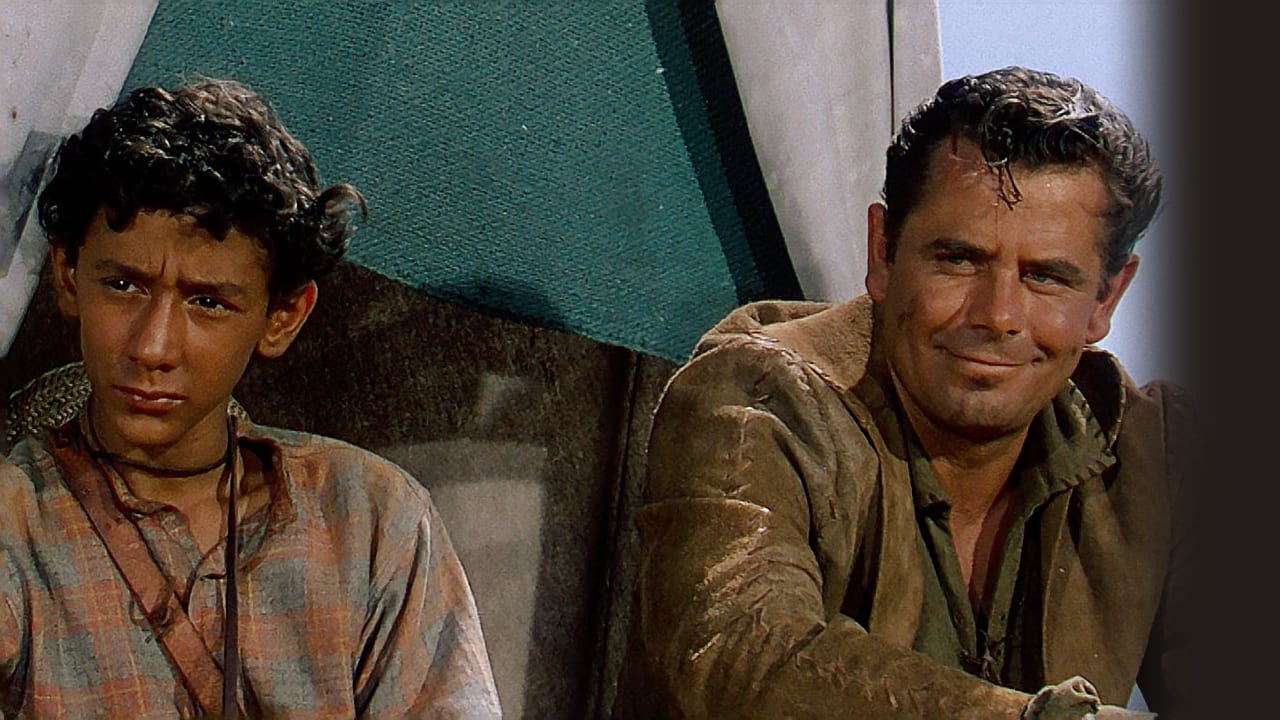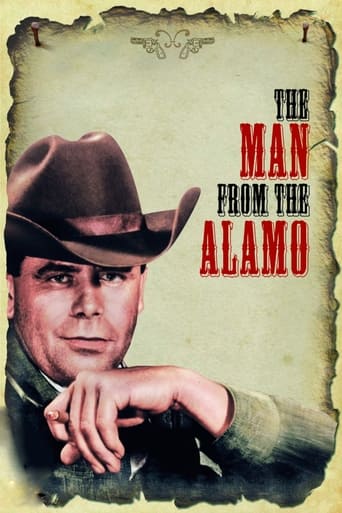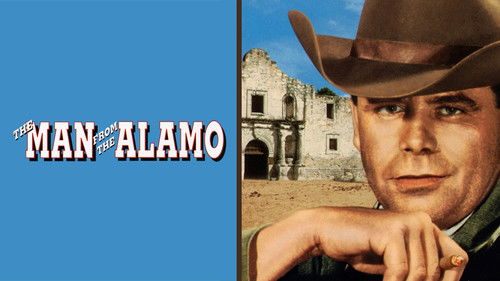


Glen Ford, as Texan settler John Stroud, finds himself threatened with death by 3 opposing groups during the fight for Texas independence from Mexico, his only apparent friend an orphan Mexican boy: the only survivor of a raid by American renegades dressed as Mexicans, who killed Stroud's family and burned his house. Stroud was one of the American defenders holed up inside the crumbling Alamo mission, being used as a fort, until he drew the black bean, used to decide who would try to ride through the Mexican lines to lead the families around his farm in a retreat. But he discovered that the renegades had already destroyed everything before he got there. The Mexican boy decides to 'adopt' Stroud as his new father, but when they go to town, the people figure out that he is the man who quit the Alamo, thus he is labeled a notorious coward. His association with the boy further suggests to them a pro-Mexican stance.The screenplay is very tightly constructed, and includes a complex web of ironies, which is one of the main selling point of the film. For example, the renegades unwittingly saved Stroud's life twice 1) the report of their proximity to some settlements caused Stroud to leave the Alamo, thus saving his life 2) Later, the renegades save Stroud from an imminent lynching by the enraged town people. This was an incidental result of their attack on the town, with the goal of robbing the bank and freeing one of their members from jail. Stroud professes his desire to join them, but they don't really trust him. Thus, he engages in several fist fights with them, the last leaving him presumably dead after tumbling down a long rocky slope. But , he is found by searching members of the fleeing townies plus cavalry protectors, and after recovering, he organizes the defense of the seemingly defenseless townies, minus their men, after the cavalry unit receives orders to immediately join Houston at San Jacinto. The women, kids, old men, and Stroud manage to annihilate the renegades, using borrowed cavalry firearms. Thus, Stroud achieves his revenge and resurrects his reputation as a brave and smart man.Chill Wills and the other townies, along with Hugh O'Brian, as commander of the cavalry unit, want to lynch Stroud when he refuses to vacate the region. Ironically, Wills is later pressured by Beth(Julie Adams) into doctoring the unconscious Stroud, after his long tumble, against an overriding sentiment to let Stroud die. Again, ironically, O'Brian's troops soon thereafter are called to abandon the wagon train and join Houston. Initially, O'Brian refuses to obey, but Stroud convinces him that he can lead an effective defense of the wagon train. Thus, the man they wanted to kill a short time before becomes their savior. Stroud effectively rescued the Mexican boy from starvation. but the association of the boy with Stroud increases the perception of Stroud as pro-Mexican, thus increasing the call to lynch him. The boy tries to tell the others why Stroud really left the Alamo, which Stroud inexplicably refuses to do. But, initially, he is disbelieved. Later, the boy saves Stroud's life by leading a search for him after he tumbled down that hill, and insisting that Wills try to revive Stroud. Also, he corroborates Stroud's statement why he left the Alamo, thus diffusing a renewed demand by the fleeing townies to kill Stroud. At the end, the implication is that Stroud, the boy, and Beth will form a new family.The biggest weakness of the screenplay is the extreme reaction of some of the Alamo defenders and of the townspeople to Stroud's leaving the Alamo, and his curious refusal to adequately explain why he did so, until late in the film. Also, Stroud recovered awfully quickly from his long tumble down that hill, and his being found by the boy is unlikely.Ford's character is very loosely based on the disputed historical fact or legend that one man(Moses Rose) chose to leave the Alamo, when given a choice. He said he saw no reason to stay and die in a hopeless defense. Thus, he was labeled a coward. Unlike the portrayal of Houston's attitude toward defending the Alamo, the historic Houston sent Bowie with instructions to remove the cannon and destroy the make-shift fort, as being indefensible! While at the Alamo, Stroud risks his life to reraise the Texas flag on the wall, while under cannon bombardment. The scenes of Mexican cannon bombardment are pretty cheesy.Only some of the firearms are the historically-relevant flint locks. The use of repeating firearms speeds up the gunplay for the audience. Yes, the women reloaded their muskets impossibly fast! Also, an obvious photocopy of President Hayes(1876-80) should have been removed from the jail wall!Several of the renegade actors took impressive body-slamming falls when shot off their horse or their horse was shot. Also, Victor Jory, as the head renegade: Jess Wade, takes quite a plunge down a waterfall. I don't see how this could have been faked. The assumption is that Wade drowned. However, it looks survivable to me, assuming a deep plunge pool.Presently, part of the Classic Western round-up, Vol. 2, DVD set, along with "The Texans", "California" and "The Cimarron Kid"
... View MoreThere is always something interesting and just a bit different in this Director's Movies. This one is no exception. It is replete with thought provoking ideas like cowardice, bigotry, loyalty, and other values only found in the better Westerns.This is an action filled Film with guns blazing, galloping Horses, Wagon Trains, bushwhackers, Mexican impersonators, fist-fights and all that is expected in this type of thing. But the difference here is the intelligence. The injection in a popular genre some things that rose above the material.Budd Boetticher, Anthony Mann, and sometimes John Ford and Howard Hawks always gave more than the raw material. This is a modest effort from one of the Greats with an OK cast and a Production that looks so much bigger than it was. That was Boetticher, he was always so much bigger and better than what he was allowed.
... View MoreDeserving of its obscurity, "The Man From the Alamo" (1953) is probably Director Budd Boetticher's weakest Western and Glenn Ford's weakest film. While not actually horrible, it is not something to seek out for exciting entertainment or for a showcase of the talent of those two Hollywood immortals. It's another of those lame historical fiction stories that would be at least tolerable if the names and places had been changed to protect the innocent. In fairness, the film would have been easier to take back in 1953, a couple of years before Fess Parker and later John Wayne told slightly less fictional Alamo stories and established lasting mental pictures of the event and the participants. "The Man From the Alamo" is probably most noteworthy for its overuse (and misuse) of "day for night" filming. There are endless "day for night" scenes with many among the worst examples I have ever seen. One camp scene is so underexposed (to simulate nighttime darkness) that it's just five minutes of disembodied voices. The scenes at the Alamo itself are lame sound- stage stuff.Also amusing are the sequences of the wagon train traversing the same California valley in scene and scene (the high hills in the background and the dry valley just don't square with the alleged East Texas location).While Boetticher was normally excellent at pacing, in "The Man From the Alamo" he dissipates the tension way too early and the film drags along to an unexciting (snore) ending. The wily renegades turn out to be totally inept cream-puffs and the viewer is left waiting for a tactical surprise that never happens. The story opens with John Stroud (Glenn Ford) as part of the Alamo's garrison. We never meet General Santa Anna but there are brief scenes with Travis, Crockett, and Bowie. Stroud and his group draw lots to see which one will leave the Alamo to protect their ranches and families from a band of renegades. But he arrives too late and finds all the ranches have been burned and most of the families killed.Since no one at the Alamo survives, Stroud is labeled a deserter and is about to be lynched in the first town he enters. But the renegades attack the town and Stroud infiltrates their merry little band led by Jess Wade (Richard Jory) so that he can get revenge. There is not much challenging acting required although Neville Brand is quite effective as one of the Renegades. Hugh O'Brien gets a lot of mock fest moments as a kind of combo of George Custer and Kit Carson; complete with a tight buckskin costume. Then again, what do I know? I'm only a child.
... View MoreGlenn Ford plays the only survivor of the Alamo -- not a very popular man in Texas. Of course, the story gives him a good excuse -- he drew lots with some other Alamo soldiers to see who would go west to defend their homes from Texan bandits hired by the Mexicans, but the families were already dead when he gets there -- but nobody wants to believe him, except one lovely woman on the wagon train he sets out to defend. Only problem is his strategy of siding with the bandits to get into their confidence puts him in a nearly impossible situation.A well-made film, with convincing action and gritty characters. Unlike other Boetticher westerns, here the scale of the film is "epic" as the future of the West hangs in the balance. Ford makes a surprisingly good substitute for Randolph Scott or John Wayne.
... View More